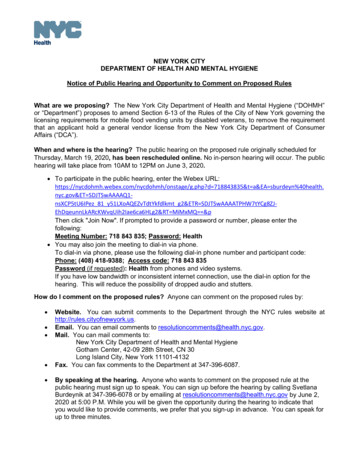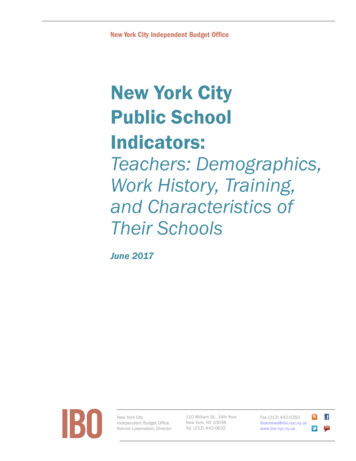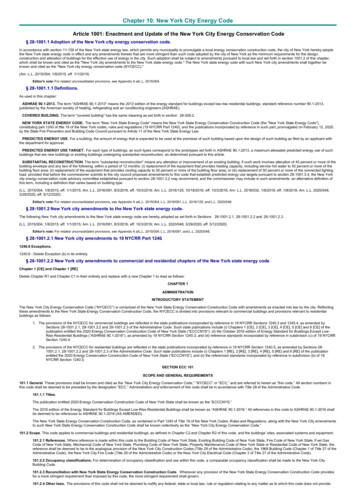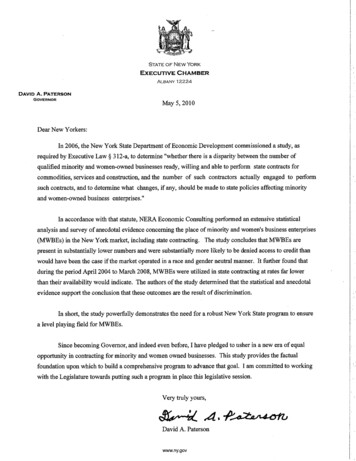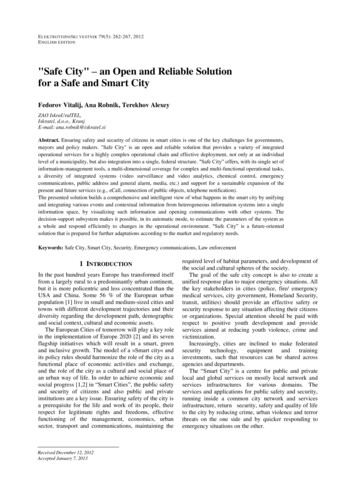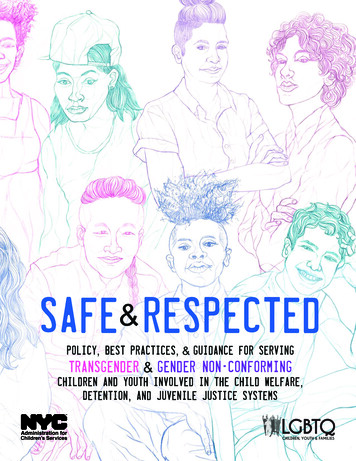
Transcription
&Safe RespectedPolicy, Best Practices, & Guidance for ServingTransgender & Gender Non-ConformingChildren and Youth Involved in the Child Welfare,Detention, and Juvenile Justice Systems
NYC Administration for Children’s ServicesThanks the Following People and Groupsfor their Contributions to this Guide:Editorial CommitteeRhodes Perry, Director of the Office of LGBTQ Policy and PracticeEli R. Green, ConsultantGraphic Design & IllustrationEmily North, ConsultantContributors and GroupsGladys Carrión, CommissionerRonald E. Richter, Family Court JudgeDawn Saffayeh, Deputy CommissionerLeslie Abbey, Associate CommissionerDenise Niewinski, Deputy Director of LGBTQ Policy and PracticeYumi Nielsen, Director of PolicyItohan Omoregie, Deputy Director of PolicyShaquana Green, LGBTQ Youth LiaisonACS LGBTQ Advisory CouncilLGBTQ Provider Point Person NetworkACS LGBTQ Action GroupSpecial AcknowledgementsNew Yorkers For ChildrenCricket Island FoundationCopyright Information 2014 New York City’s Administration for Children’s Services’ Office of LGBTQ Policy and Practice,www.nyc.gov/acs/lgbtq. We encourage, and grant permission to, reproduction and distribution of this publicationin whole or in part, provided that it is done so with attribution. Further written permission is not required.Recommended Citation: Perry, J.R. & Green, E.R. (2014). Safe & Respected: Policy, Best Practices & Guidancefor Serving Transgender & Gender Non-Conforming Children and Youth Involved in the Child Welfare, Detention,and Juvenile Justice Systems. New York City, NY: New York City’s Administration for Children’s Services.
ContentsTable of Contents1. Using this Guide . 22. Transgender & Gender Non-Conforming Youth: A Vulnerable Population . 33. Providing Transgender-Inclusive Care: Six Strategies for Success . 54. Children’s Services Non-Discrimination Policies and Commitment to Respectful Care . 65. Addressing Verbal Harassment, Microaggressions, & Bullying . 96. Addressing Physical Aggression & Violence . 117. Access to Safe & Affirming Housing . 138. Affirming & Appropriate Gender Segregated Placements . 159. Respecting Privacy & Purposeful Disclosure . 1710. Preferred Name, Pronouns & Identity Language . 1911. Documentation & Records . 2112. Gendered Spaces: Bathrooms, Locker Rooms, & Showers . 2313. Hair & Personal Grooming . 2514. Clothing & Dress . 2715. Coming Out & Social Transition . 2916. Referrals to Transgender-Inclusive Services . 3017. Medical Transition: Pubertal Suppression & Hormone Blockers . 3218. Medical Transition: Hormone Use Prior to Entering Care . 3419. Medical Transition: Hormone Requests While In Care . 3620. Medical Transition: Surgical Interventions . 3821. Staff Cultural Competency Training . 4022. TGNC Affirming Literature & Written Materials . 4223. Outreach Efforts for LGBTQ Foster Parents . 4324. Assessing Cultural Competency of Foster Homes . 4425. Reporting Procedures & LGBTQ Incident Reporting Form . 4526. Appendix 1: Respectfully Asking Identity Questions . 4727. Appendix 2: Educational Resources for Providers . 4928. Appendix 3: Community Resources for TGNC Youth . 5229. Appendix 4: Glossary of Transgender & Gender Non-Conforming Terms . 5730. Notes . 62Safe& Respected1
TGNC1. Using This GuideThis guide is organized by the key areas of need for transgender and gender non-conforming (TGNC)children and youth.The guide includes: A brief overview of the barriers that TGNC children and youth are currently facing while in Children’sServices’ care; A glossary of terms commonly used when discussing TGNC people found in Section 29; An overview of Children’s Services’ commitment to providing culturally competent care for TGNC childrenand youth. Cultural competence refers to an ability to interact and work effectively with people ofdifferent cultures, socio-economic experiences, and backgrounds; An issue-by-issue guide to providing inclusive care, including: Excerpts of the Children’s Services’ policies related to serving TGNC children and youth, Best practices for service provision that are consistent with these policies, Strategies for implementing these policies with fidelity, and Common missteps to avoid when working with TGNC children and youth.At the end of this guide, you will find appendixes with resources and referrals that will be of use in supportingthe transgender and gender non-conforming children and youth with whom you presently work, or will workwith in the future. For further guidance on supporting TGNC youth in Children’s Services’ care, please contactthe LGBTQ point person for your site, or the Children’s Services’ Office of LGBTQ Policy and Practice.2Safe& Respected
Vulnerable2. Transgender & GendeR Non-Conforming (TGNC)Children & Youth: A Vulnerable PopulationThere are increasing numbers of youth who are coming out as transgender and gender non-conforming(TGNC), and youth are coming out at earlier ages than ever before.1 Logistical factors and researchconstraints make it impossible to provide concrete data on the numbers of TGNC children and youth in fostercare and juvenile justice settings; however, multiple studies have indicated that TGNC young people aredisproportionately represented.2 These studies have also indicated that TGNC youth are facing significantprejudice and discrimination related to their TGNC identity while in the foster care and juvenile justice systems,and that this increases the negative outcomes for these youth.3TGNC people and TGNC children and youth in particular are an especially vulnerable group.4 TGNC youth havebeen identified as an especially vulnerable population within the already high-risk population of youth in fostercare and juvenile justice settings.5 Limited research has been conducted on the specific experiences of TGNCyouth in foster care; however, the overall vulnerabilities of TGNC people are well documented: TGNC young people may experience rejection from their families of origin and be kicked out of their homes.6 57% of TGNC people who were out to their families reported experiencing family rejection.7Verbal harassment was very common, and 87% of TGNC young people report facing it often orfrequently.8Over 53% of TGNC people had been verbally harassed or disrespected, and 44% had been denied servicebecause they were TGNC.9 76.6% of TGNC people reported feeling physically unsafe in public on aregular basis.10A total of 42% of the TGNC young people reported that they had been physically harassed in their schoolby peers because of their gender identity. 44% of those reported that they had been punched, kicked, orattacked with a weapon, and 17% reported that they were physically harassed often or frequently. Ofthe youth who reported being harassed by peers, only a third indicated that there had been an effectiveresponse by teachers or the administration.11TGNC young people reported being subject to vicious rumors, cyber bullying, destruction of their personalproperty, and being generally ostracized and excluded by their peers.12TGNC people face high rates of physical attack (16%) and sexual assault (15%) while incarcerated.TGNC people of color consistently face higher levels of discrimination and prejudice. Negative outcomes as aresult of this wide-spread prejudice and discrimination against TGNC people has also been well documented: TGNC youth, 24 years of age and under, are at particularly high risk for homelessness, with reportsindicating that 20% of the homeless youth identify as transgender.13 TGNC people who were rejected by their families of origin, partners, or children are more likely to havegreater negative outcomes.14 Rates of suicidality doubled, as did sex work, and homelessness tripled. TGNC people who are physically assaulted by a family member as a result of coming out (19%), havedouble the rate of HIV infection and suicide attempts, and four times the amount of sex work andhomelessness.15 TGNC youth who reported high levels of harassment averaged a 2.2 grade point average (GPA), whileTGNC youth who faced less harassment had an average GPA of 3.0.16Safe& Respected3
As a result of going to school in an unsafe environment, 47% of the TGNC youth reported skipping atleast one class in the last month, and 46% reported missing a full day of school at least once in the pastmonth because of the harassment that they faced.17 Pervasive negative experiences can have a significant impact on TGNC young people’s mental health andemotional well-being.18Children’s Services is committed to supporting the physical and emotional health and well-being of all childrenand youth, including TGNC young people, who are in Children’s Services care. Children’s Services requires thatall TGNC young people be placed in safe housing, receive TGNC affirming medical and mental health services,and have equal opportunity and access to care. All Children’s Services staff, providers, and foster parents arerequired to treat TGNC young people in an affirming manner and to proactively work to create a respectfulspace. All Children’s Services staff, providers, and foster parents are expected to be culturally competent inserving the needs of TGNC young people, including understanding the challenges that TGNC youth face in thefoster care and juvenile justice systems.It’s important to note that we don’t always know which youth are TGNC; therefore, it’s critical that we modelrespect and value for all youth regardless of their gender identity or gender expression. Additionally, staffin emergency facilities must be especially sensitive to the needs of, and be culturally aware in serving TGNCchildren and youth. This degree of professionalism is critical given that emergency facilities are an importantentry point for children and youth in foster care and juvenile justice systems.To this end, Children’s Services has issued three policies that address and protect the specific needs of TGNCyouth: Promoting a Safe and Respectful Environment for Lesbian, Gay, Bisexual, Transgender and Questioning(LGBTQ) Youth and their Families Involved in the Child Welfare, Detention and Juvenile Justice System. Non-Discrimination Policy, Youth & Families Non-Medicaid Reimbursable Treatment or Services for Youth in Foster Care (in revision)COPIES OF THESE POLICIES & RELATEDRESOURCES ARE AVAILABLE ONLINE AT:WWW.NYC.GOV/ACS/LGBTQ4Safe& Respected
6 Strategie3. Providing Transgender-Inclusive Care:Six Strategies for Success9Be Aware.There are an increasing number of people who are coming out as transgender and gender non-conforming(TGNC), and many are coming out as children and adolescents. Additionally, there are a disproportionatenumber of TGNC youth in foster care systems. Many of these young people do not feel that they will be safeor supported if they disclose their gender identity. It is likely that you are already working with TGNC youthand youth with TGNC family members, and it is certain you will work with more in the future.9 Be Knowledgeable.It is essential that all Children’s Services staff working directly with children, youth, and families havegeneral knowledge about TGNC people, a strong understanding of the specific needs of TGNC youth infoster care/detention, and the professional skills to provide transgender-inclusive care. All such staffare encouraged to seek out professional development trainings to help increase their level of culturalcompetency for working with TGNC youth and families.9Be Sensitive.Gender influences nearly every part of a person’s life, and those who are TGNC are often acutely aware ofthis. Any time TGNC young people meet or interact with someone, they may be confronted with at timesinaccurate assumptions about their gender, expectations to conform to gender norms, and bias/prejudicetoward people who are TGNC. As a result, TGNC young people may be less likely to trust or be open withnew people, and are more likely to have increased mental health challenges, such as depression or anxiety.9Be Prepared.With a little advanced preparation and effort, you can have a big impact on the success of TGNC youngpeople’s care. Know who your LGBTQ point person is, and utilize that person’s expertise. When consideringreferrals for other services, call ahead and ask questions to determine if or which providers are culturallycompetent in working with TGNC youth. Keep a list of the individual providers at these sites who areinclusive and make sure that the youth see the inclusive providers. Remember, not all LGBTQ providers orall individual providers at a site are inclusive of or prepared to work with TGNC youth.9 Be Proactive.TGNC youth face distinct challenges. It is essential that Children’s Services and provider agencies’ staffunderstand these challenges, and proactively create policies and procedures to support TGNC youth. Thiswill prepare all staff to better work with TGNC youth, and that all TGNC youth entering care will havetheir needs met upon entry. These policies should be made available to youth and staff at all times.9Be an Ally & Advocate.TGNC youth face a significant amount of prejudice and discrimination. Every time you see other staff oryouth making negative remarks, bias statements, verbal or physical remarks, or not respecting name andpronoun preferences, it is your responsibility to intervene and report the incident. By paying extra attentionand speaking up, you can dramatically increase young peoples’ safety, self-esteem, and sense of support.Safe& Respected5
policies4. Children’s Services’ Non-Discrimination Policies& Commitment to Respectful CareThe ChallengeTransgender and gender non-conforming (TGNC) children and youth are disproportionately represented inthe foster care population, and are particularly vulnerable due to widespread anti-transgender bias, prejudiceand transphobia.19 These youth are at high risk for associated negative outcomes, including dropping out ofschool, being homeless, increased drug/alcohol use, contracting sexually transmitted infections including HIV,depression, and suicidal ideation.20As the Agency responsible for promoting the emotional, psychological, and physical well-being of youth infoster care, detention, and juvenile justice placement, Children’s Services is committed to supporting that allTGNC youth are treated with dignity, respect and equality in a way that affirms their gender identities andexpressions, builds resiliencies, and leads to positive outcomes as these young people transition into adulthood.6Safe& Respected
The NYC Human Rights LawThe following is an excerpt from Guidelines Regarding Gender Identity Discrimination(available at www.nyc.gov/html/cchr/pdf/GenderDis English.pdf)The City Council finds and declares that it is in the interest of the City of New York to protect its citizens fromdiscrimination. Discrimination, prejudice, intolerance and bigotry directly and profoundly threaten the rightsand freedom of New Yorkers. The City Council established the Human Rights Law to protect its inhabitantsfrom these dangers. Included in the City’s Human Rights Law is a prohibition of discrimination againstindividuals based on gender. The scope of this gender-based protection, however, requires clarification. This locallaw is intended to make clear that all gender-based discrimination—including, but not limited to, discriminationbased on an individual’s actual or perceived sex, and discrimination based on an individual’s gender identity,self-image, appearance, behavior, or expression—constitutes a violation of the City’s Human Rights Law.Relevant NYC Children’s Services’ Policies:The following are excerpts from Promoting a Safe and Respectful Environment for LGBTQ Youth and theirFamilies Involved in the Child Welfare, Detention and Juvenile Justice System, pages 6-8: It is Children’s Services policy that all transgender and gender non-conforming youth shall be in homes and congregate facilities that are affirming of their gender identities. This applies to all Children’s Servicesand contracted provider agency staff involved in any way with custodial or community-based servicesprovided by Children’s Services or in contract with Children’s Services.Children’s Services is committed to being respectful of the dignity of all youth and families, and to keepingchildren and youth safe while meeting their specific needs, regardless of their sexual orientation, genderidentity or expression. No Children’s Services or provider agency staff shall unlawfully discriminateagainst other persons in the course of their work. Discrimination on the basis of sex, gender identity, andgender expression is prohibited.Under no circumstances is any staff member of Children’s Services or its provider agencies to attempt toconvince a transgender or gender non-conforming youth to reject or modify their gender identity or genderexpression.Children’s Services and provider agency staff must model appropriate and affirming behavior at all times.This means that bias, discrimination, bullying or harassment by staff or by youth towards youth and/orfamilies is not tolerated, and immediate action to intervene in any such situation must be taken by staff.Violations of these policies are to be reported to the Children’s Services’ LGBTQ Office of Policy andPractice by filling out Form FSS-009, the LGBTQ Incident and Inquiry Report.The Best Practices & Strategies: Respect, validate, and support the needs of TGNC young people, in the same manner that you wouldrespect, validate, and support any young person’s needs. Basic ways to respect TGNC young peopleinclude-but are not limited to-referring to them by their preferred name and pronoun and supporting theirexpression of their gender identity through clothing, hairstyles, and mannerisms. Appropriately respond to discrimination, harassment, and disrespectful treatment by role modelingthe best practices included in this guide, and reporting any violation of Children’s Services policy (seeSection 25: Reporting Procedures & LGBTQ Incident Reporting Form). Taking such actions help create asupportive and respectful environment for TGNC youth. Attend mandatory TGNC trainings for youth, staff, volunteers, and foster parents to understand andincorporate the best practices offered in this guide. Trainings should be offered multiple times each year toSafe& Respected7
welcome new staff, volunteers, and foster parents, and they should also be offered as continuing educationand professional development to veteran staff.Practices to Avoid Do not use personal, organizational, and/or religious beliefs to justify discrimination, harassment, ordisrespectful treatment of a TGNC person’s gender identity or gender expression. TGNC people have theright under NYC’s Human Rights Law, and the Children’s Services Non-Discrimination Policy to havea safe and affirming environment. Furthermore, the Children’s Services LGBTQ Policy prohibits staff,providers, volunteers, and foster parents from using these beliefs to negatively impact TGNC children,youth, and adults. It is important to seek out training to better understand what words and actionsnegatively impact TGNC young people. Do not bargain with TGNC young people to reject or modify their self-determined gender identityor gender expression as a means to limit or reduce discrimination, harassment, and/or disrespectfultreatment. Trying to alter one’s core gender identity causes significant trauma and harm to TGNC youngpeople’s mental health and emotional well-being. Do not engage, encourage, or ignore discrimination, harassment, or disrespectful treatment of TGNCyoung people. Such harmful treatment includes intentional use of an incorrect name or pronoun, andother verbal abuse, and has a demoralizing and traumatizing impact on TGNC young people, as well as onother young people who may be observing, no matter if they identify as TGNC (see Section 25: ReportingProcedures & LGBTQ Incident Reporting Form).8Safe& Respected
bullying5. Addressing Verbal Harassment, Microaggressions & BullyingThe ChallengeVerbal harassment is one of the most commonmanifestations of prejudice, and 87% of TGNCindividuals are verbally harassed often or frequently.21For TGNC youth, this can include facing vicious rumors,cyber bullying, destruction of their personal property,and being generally ostracized and excluded because oftheir gender identity.22 TGNC youth also face consistentmicroaggressions (e.g., derogatory language, hostiletone, negative facial expressions, social exclusion).23Cumulatively, these pervasive negative interactionscreate an unsafe and hostile environment, and have asignificant impact on TGNC young people’s emotionalwell-being.24 It is essential that Children’s Servicesproviders and staff are aware of, and diligently workingto address, verbal harassment and bullying.Relevant NYC Children’s Services’ Policies:The following are excerpts from Promoting a Safe andRespectful Environment for LGBTQ Youth and theirFamilies Involved in the Child Welfare, Detention andJuvenile Justice System, pages 2, 6-8: Children’s Services is committed to providing allyouth and families served by Children’s Servicesand our contracted provider agencies a safe,healthy, inclusive, affirming and discrimination-freeenvironment. It is Children’s Services policy that all transgenderand gender non-conforming youth shall be in homesand congregate facilities that are affirming of theirgender identities. Staff must set a good example and make youthand families aware that any threats of violence,disrespectful and/or suggestive comments, orgestures toward any youth will not be tolerated.Staff also shall not engage in these behaviors.Safe& Respected9
Children’s Services and provider agency staff must model appropriate and affirming behavior at all times.This means that bias, discrimination, bullying or harassment by staff or by youth towards youth and/orfamilies is not tolerated, and immediate action to intervene in any such situation must be taken by staff. Staff must be aware that TGNC youth are particularly susceptible to trauma, discrimination and abusewhile in congregate care facilities. Staff must be able to recognize the signs of distress, support disclosurewhen appropriate, and follow appropriate protocols for reporting.The Best Practices & Strategies Staff should be aware that TGNC youth are particularly targeted for verbal harassment and haveincreased vulnerability for related trauma. It is essential that staff regularly check in with TGNC youth tomake sure that they feel safe, supported and affirmed in their placement. Staff should be aware of and be able to recognize the different ways that prejudice and bias impact TGNCyouth. It is all staff members’ obligation to consistently and proactively intervene in all instances of verbalharassment, microaggressions and bullying. Staff should be aware that TGNC youth may pay particular attention to how they are treated by staffmembers as an indicator of whether or not the staff member is trustworthy and supportive. Staff should role model respectful behavior at all times and hold each other accountable so that they areacting in an affirming and supportive manner. If staff are engaging in behavior that is not affirming, anystaff person who witnesses the incident is responsible for reporting it to the LGBTQ point person andChildren’s Services’ Office of LGBTQ Policy and Practice. (See Section # 25 for further guidance onreporting requirements.) Practices to Avoid: It is essential that staff do not ignore instances of verbal harassment, microaggressions or bullying. Doingso indicates to TGNC youth that a space is not safe and affirming, and indicates to cisgender youth (i.e.,youth who are not transgender) that aggression towards TGNC people is condoned. All incidents must beaddressed.10Safe& Respected
violence6. Addressing Physical Aggression & ViolenceThe Challenge:Transgender and gender non-conforming (TGNC) youth are particularly vulnerable to physical threats andviolence, including sexual assault. Research has shown that of TGNC youth who are “out” in schools, 35%experience physical assault, 12% experience sexual assault, and 76% of TGNC people report feeling physicallyunsafe in public.25 Peer on peer violence is intense, and 42% of TGNC youth are physically harassed by theirpeers; 44% of TGNC youth reported that they had been punched, kicked, or attacked with a weapon, and 17%reported that they were physically harassed often or frequently.26 It is reasonable to assume that youth inChildren’s Services’ care face the same level of risk from their peers. Bathrooms, locker rooms and showers areplaces where TGNC youth are especially vulnerable to physical threats, attacks and sexual assault.27 ACS staffand providers must make efforts to protect the physical safety of all TGNC youth at all times.Safe& Respected11
Relevant NYC Children’s Services’ Policies:The following are excerpts from Promoting a Safe and Respectful Environment for LGBTQ Youth and theirFamilies Involved in the Child Welfare, Detention and Juvenile Justice System, pages 2, 8: Children’s Services is committed to providing all youth and families served by Children’s Services and ourcontracted provider agencies a safe, healthy, inclusive, affirming and discrimination-free environment. Staff must set a good example and make youth and families aware that any threats of violence,disrespectful and/or suggestive comments or gestures toward any youth will not be tolerated. Staff alsoshall not engage in these behaviors. Staff must be familiar with the unique family dynamics that emerge for TGNC youth in general, and forTGNC youth involved in the child welfare system specifically. All staff must be aware that many TGNCyouth, particularly those involved in the child welfare or juvenile justice systems, have had experiences oftrauma (e.g. violence, sexual abuse, verbal harassment, etc.) related to their gender identity/expression. Staff must be aware that TGNC youth are particularly susceptible to trauma, discrimination and abusewhile in congregate care facilities. Staff must be able to recognize the signs of distress, support disclosurewhen appropriate, and follow appropriate protocols for reporting.The Best Practices & Strategies Every threat or instance of violence should be taken seriously and immediately addressed by staff. Allsituations involving physical violence should be reported to the LGBTQ point person and Children’sServices’ Office of LGBTQ Policy and Practice. (See Section #25 for further guidance on reportingrequirements).Practices to Avoid: Under no circumstances should physical violence, sexual assault or threats of either be ignored, tolerated,or condoned by staff. Furthermore, if youth are aggressive (no matter their gender identity), precautionsneed to be taken globally, and not to unjustly target TGNC youth because of their gender identities. Do not ignore threats of violence, dismiss TGNC young people’s fear for safety, or diminish the severity ofsituations involving physical or sexual violence. It is essential that TGNC youth are confident that staffwill take all necessary steps to support their safety—including changing placements when young people’semotional and physical safety are at risk. TGNC youth should not automatically be penalized or punished for protecting themselves from physicalor sexual violence. In instances where TGNC youth are involved in physical altercations, staff should bediligent in assessing whether or not any actions on the part of TGNC young people are in self-defense.Staff should follow appropriate protocol o
4 Safe&Respected As a result of going to school in an unsafe environment, 47% of the TGNC youth reported skipping at least one class in the last month, and 46% reported missing a full day of school at least once in the past month because of the harassment that they faced.17 Pervasive negative experiences can have a significant impact on TGNC young people's mental health and




